Will TikTok Be Banned? Here’s What to Do
As policymakers in the United States debate the fate of TikTok, marketers are keeping a close eye on the potential ripple effects.

Instagram Hashtags may not seem strategic, but they are among the most critical aspects of your Instagram posts when trying to expand your organic reach and grow your audience.
Selecting the right hashtags creates visibility for your content and can interject your brand and products into existing conversations with your target audience.
Hashtags are used differently on each social channel, so when considering hashtags for Instagram, you’ll want to consider a few questions upfront:
On business accounts, Instagram provides aggregate data letting you know which percentage of post views came from hashtags. To access this, take the following steps:
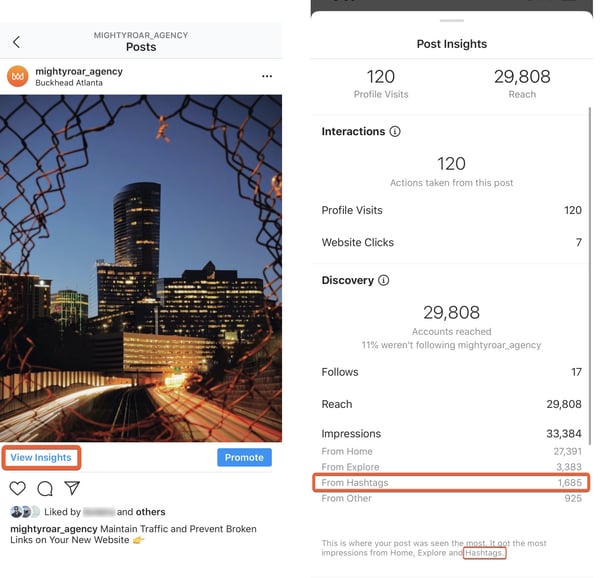
There is no silver bullet when it comes to finding the best hashtags for your brand, but there are paid tools that can provide a little more in-depth data to help understand the value behind specific hashtags once used.
Using this data, you can begin to identify high-engagement hashtags, weed out low-engagement hashtags, and test new hashtags.
Depending on the size of your Instagram following, this is most likely an area where less (volume) is more (engagement).
It may seem logical to use hashtags with the highest volume of posts, but if your goal is to grow your niche audience and increase the discoverability of your content, you’ll want to use relevant hashtags with lower volume.
Think of it like this: if you use #yoga (84.5 million posts), you’re less likely to make and remain on the explore page for that hashtag than if you used a lower-volume hashtag like #yogatime (1.6 million posts), #yogabeginner (449k posts), or #yogawoman (147k posts).
A great place to research lower-volume hashtag alternatives is in the related section on the high-volume hashtag’s page.
To gain an understanding of what it would take to make the explore page of a particular hashtag, take a look at some of the top posts for that hashtag and see if you can infer how much engagement (likes, comments) you would need on your post to compete.
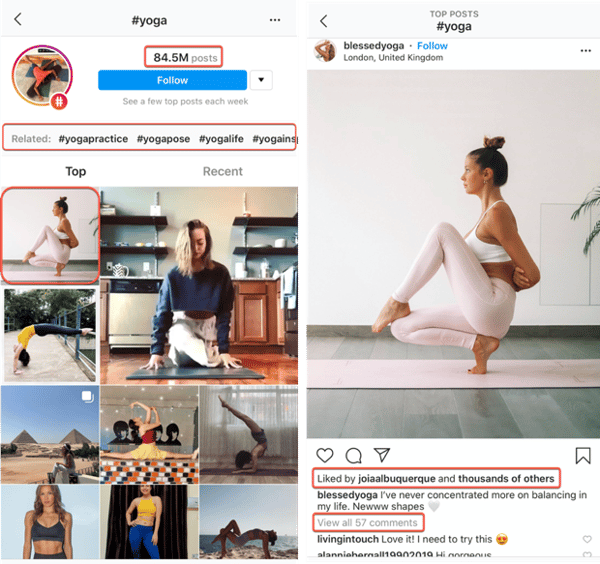
Now you may be thinking, “lower volume means fewer people will see it.”
Theoretically, yes, but realistically your odds of making it to the top of the explore page ahead of 84.5 million other posts are close to zero, which is about how many people will see your content via that hashtag.
This doesn’t mean that you can’t use large volume hashtags at all, just that you should use them sparingly, and in addition to lower volume hashtags to drive engagement.
Keep in mind that there are different types of hashtags on Instagram. There are community hashtags like #SaturdayStyle or #FoodStagram that connect likeminded users.
Then there are branded hashtags like Peloton’s #onepeloton or Lululemon’s #TheSweatLife. These can promote your brand, build community, and collect user-generated content.
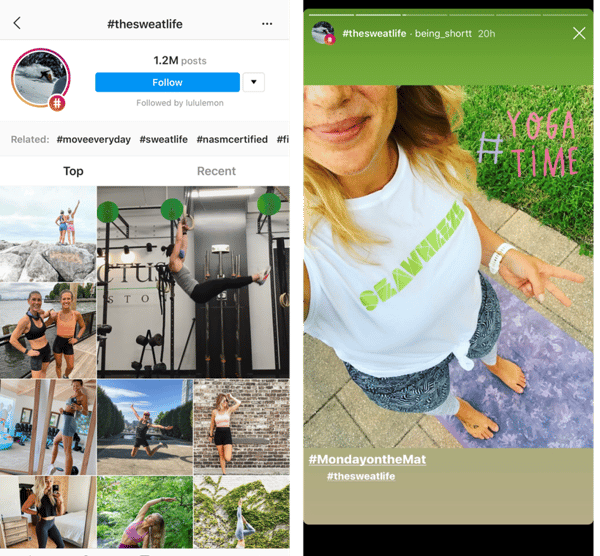
There are also event or campaign hashtags tied to specific periods in time like a new product launch or a trade show.
The most important thing when it comes to selecting hashtags is to do so with your target audience in mind. Learn what hashtags they are already using and engaging with in their posts and stories and adapt your strategy accordingly.
Instagram allows you to use up to 30 hashtags in your posts. While there is a benefit to using everything available to you to improve your engagement rate, we realize that it will also take up space in your caption or first comment and run the risk of looking spammy.
To find the right number of hashtags for you, you’ll want to be mindful of your audience and their expectations.
Consider using about ten hashtags per post and putting them in the first comment rather than the actual post caption to keep things clean. When using the first comment to place your hashtags, it’s best to add them immediately after posting your image. Hashtags added much later within the comments do not work.
Make sure you're not using the same hashtags in each post as that may signal to Instagram causing their algorithm to penalize your post or account for using repetitive content. It’s best to cycle in new hashtags to avoid penalties and ensure your hashtags are relevant to the image and caption.
As you research different hashtags, consider creating groups of tags that you can easily pull and use again in later posts. This way, you don’t have to start from scratch each time, and you can begin to identify hashtags that perform better over time.
Ultimately, your hashtag research should align with the following groups that should be mixed-and-matched in your posts:
Given that Instagram is a highly visual channel, it’s not surprising that profile bios tend to get overlooked.
However, your name and bio are searchable within Instagram, so you’ll want to take advantage of that. Consider adding a few hashtags contextually to promote your brand and category.
Depending on your business, there may be an opportunity to include a call-to-action within your bio inviting others to tag you in their photos using a branded hashtag.
Doing so will help raise brand awareness and allow you to view and collect user-generated product photos and engage in the comments with people who may be new to your brand.
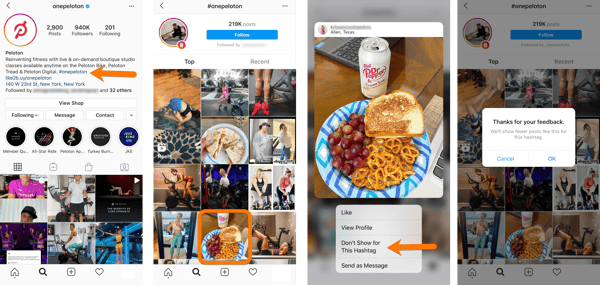
Lastly, remember to review and moderate your branded tag to address and remove any unflattering or unrelated images from the page. You (and any user) can suggest removal of an image by long pressing the thumbnail and selecting “don’t show for this hashtag.”
Stories have become more of a focus on Instagram over the past year. In fact, as of last year, roughly half of Instagram’s users – or 500 million people – were interacting with Stories daily.
Stories have become so popular that Instagram is currently testing a new feature that will allow users to see more stories at once, both on the home screen and in a new Stories-only experience.
People often forget that hashtags can be used within Stories to expand your reach. This happens because popular hashtags will generate a collection of stories that use those hashtags on the explore page.
You can add up to ten hashtags to each Instagram story, including one clickable hashtag sticker.
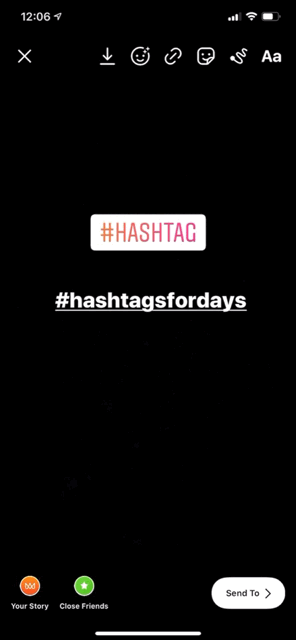
Again, ten hashtags on a story may seem like clutter, but keep in mind that you can pinch-and-reduce the size of your hashtags, or hide them under an image, gif, or sticker if you don’t want them too visible.
You can follow hashtags within Instagram, allowing you to stay up to date on topics relevant to your business and your audience.
Following hashtags provides some quick research into their use and what associated content plays well with the audience. This information can not only influence your hashtag use, but post creative and copy as well.
If you’re using a branded hashtag, consider inviting your followers to follow your hashtag every so often to see new products, information, or top posts.
The truth is, large, established brands and celebrities can often get away without using hashtags. However, if you’re trying to grow your brand and your Instagram following, hashtags are an integral part of the Instagram culture and play a key role in the success of an account.
However, using hashtags sporadically and without a plan in place won’t deliver any benefits. If you want to gain more from hashtags, you must be willing to use data and experiment.
With the addition of Instagram Reels, there is now another way to leverage hashtags and have your content discovered by new audiences. While we're still learning more, it currently appears that the algorithm behind Reels will act similar to TikTok, meaning that your captions and hashtags will help Instagram understand which audience niche to which your content will be most relevant. Learn more in our guide to Instagram Reels.
Sign up for our monthly newsletter to receive updates.
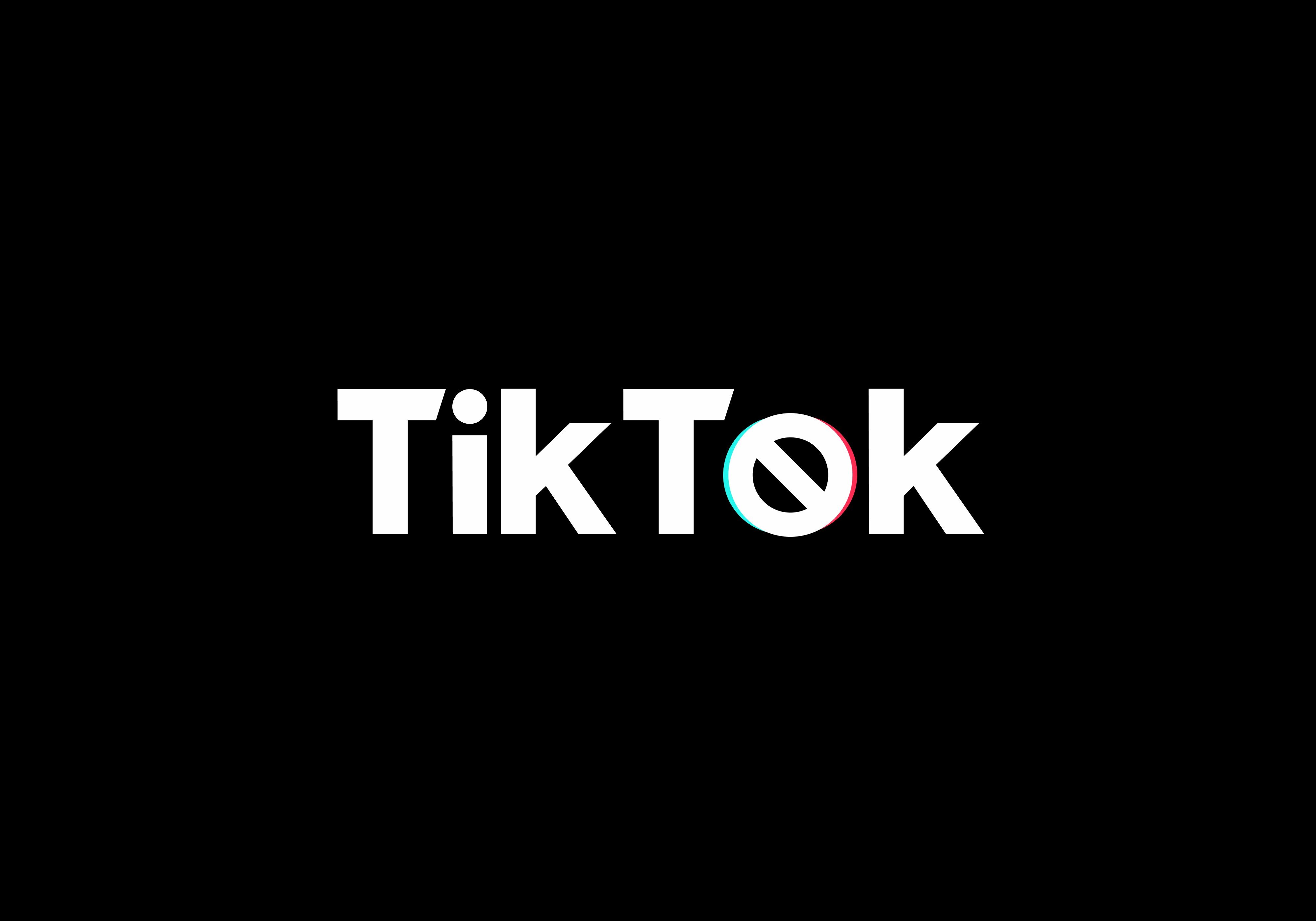
As policymakers in the United States debate the fate of TikTok, marketers are keeping a close eye on the potential ripple effects.

When it comes to hotel marketing, showcasing your property is of utmost importance. Prospective guests not only need to get a sense for the type of...

The holiday season is a pivotal time for many businesses—a period relied upon to boost sales, engage with customers, and strengthen brand loyalty.